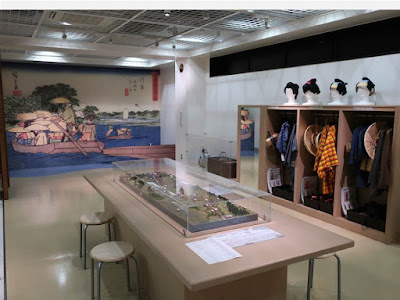Kawasaki city is between
Tokyo and Yokohama with a population of around 1.5 million. The city
changed completely compared to the Edo period. This community center
introduces the history and culture of Kawasaki-shuku mainly in the Edo period
using replicas and videos. You can wear old outfits and take photos.
往時の面影がなくなった川崎宿の歴史や文化を伝えていく、博物館ではなくて交流館である。昔の物が展示されているわけではないが、映像や復元品で昔の様子が分かりやすく展示されている。また、昔の旅装束を借りて写真を撮ることができ、楽しめるようになっている。会議室も充実しており、「地域活動・地域交流の拠点となることをめざして整備された施設」とパンフレットに書かれていた。
人の楽しみとしては、龍ヶ崎市歴史民俗資料館の企画展で紹介されていた庄屋が、金策のために三河に向かう途中で立ち寄ったと紹介されていた万年屋、そして名物の奈良茶飯が紹介されていたし、人々が揚々として出かけた旅の様子が、映像や写真で描かれていた。
The photo shows the model of “Mannen-ya
(10,000 years shop)” restaurant and inn. It was famous for its specialty “Nara-tea-rice”
which was described in an old popular travel novel called “Toukaoidoucyuu
hizakurige” (https://en.wikipedia.org/wiki/T%C5%8Dkaid%C5%8Dch%C5%AB_Hizakurige). In Ryugasakicity museum of history and folklore, a travel of a village head was introduced
in the thematic exhibition and he had a lunch here 200 years ago.
奈良茶飯が名物の万年屋の紹介コーナー。食べやすいお膳だったらしい。東海道中膝栗毛に書かれて有名になったという。さらさらと食べられたものだったらしい。
 |
| Travel guidebooks and gadgets in the Edo period |
 |
| Guidebook of Naniwa-kou |
 |
| Tag and bag of Naniwa-kou member |
Naniwa-kou was an organization of good inns
and they issued their tags which were similar to the membership cards. Travelers who owned the tags could stay at inns of
Naniwa-kou. There were many unscrupulous inns at that time, so Naniwa-kou was a
secured member’s club.
浪速講と言う優良旅館組合があり、そこに泊まるための札があった。会員制リゾートクラブのようなものか。知らなかった。
 |
| Outfit of various travelers |
You can wear wigs and outfits on the right and
take photos in front of the Edo picture. This is fun!
右側のかつらや旅装束を身に着けて、六郷の渡しの絵の前で写真を撮れるコーナー。面白いです。
 |
| Kawasaki-syuku now and then、川崎宿の今昔 |
 |
| Outside of this center |
 |
| Old Toaidou in front of this center、旧東海道 |
 |
| Kawasaki-daishi Temple near the center、川崎大師 |
Kawasaki-daishi
Temple has been popular since Tokugawa Shougun worshipped. Around three
million people surge from the New Year’s Day and the 3rd of January every
year.
Reference:
Four funs(楽fun)were found. Visited in May, 2018
Website :
Website :
http://kawasakishuku.jp/24_english/index.html
(English, brochure)
http://kawasakishuku.jp/index.html
(Japanese), accessed in January, 2019
Previous post (The first post town in
Toukaidou) : Shinagawa
Historical Museum 品川区立品川歴史館
Next post (The third post town in Toukaidou)
: Yokohama History Museum 横浜市歴史博物館



Comments
Post a Comment